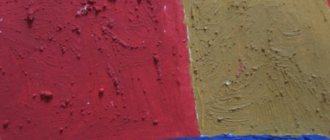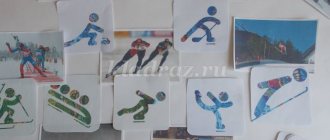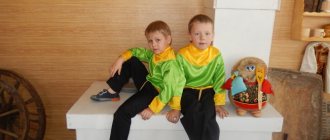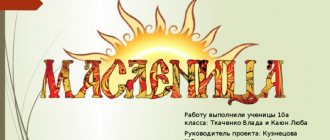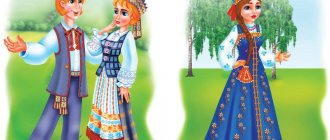Project "Creative Workshop" project (senior group)
Senior group project
"Creative workshop".
Prepared and conducted by: Kuznetsova E.A.
Type of project: short-term from January 16-22.
Project participants: senior children, parents, teachers.
Relevance: Non-traditional techniques are an impetus for the development of imagination, creativity, the manifestation of independence, initiative, and expression of individuality. By using and combining different methods of depiction in one drawing, preschoolers learn to think and independently decide which technique to use to make this or that image expressive.
Goal: Development of children's creative abilities, imagination, imagination through non-traditional drawing.
Identification and development of creative abilities in older children through entertaining activities.
Tasks:
1.Introduce children to non-traditional drawing techniques.
2.Avoke emotional responsiveness in children.
3. Expand the possibilities of using non-traditional drawing techniques.
4.Form a sustainable interest in creative activities.
Working with parents:
— Consultation for parents “Unconventional drawing.”
— Bring cardboard tubes.
— Make salt dough for class.
| Educational area | Forms of organizing the activities of a teacher with children |
| Social and communicative development | Fix “Safety rules when working with scissors” Duty in a corner of nature: loosening the soil of indoor plants. Observation: trees in January. Reading a poem by A.A. Feta “As soon as the sun warms at noon, the linden tree in the heights blushes...” Role-playing game: “Artists” |
| Cognitive development | Video presentation D/i “Houses on the composition of numbers. Training apparatus". D/i “Find it in the picture.” Creative workshop: coloring with pencils. Salt dough mosaic. |
| Speech development | Conversation “Who are artists?” |
| Artistic and aesthetic development | Application “Rain of Hearts” Do-it-yourself volumetric paints. Crafts from cardboard tubes. Origami "House". Constructor made from paper circles. Drawing with semolina |
| Physical development | P/i "Fishing Rod". Difficulty: Players must perform jumps on one leg. Russian folk song "Wolf and Goat" Sports game badminton. Sports game hockey: game situation “International tournament”. |
Appendix No. 1.
Constructor made from paper circles.
Great idea and very simple. You can build amazing structures. Both simple and very complex. You can take this construction set with you on the road or invite your child to play in a cafe.
Appendix No. 2.
Volumetric paints.
Equipment:
- PVA glue,
- shaving foam,
- dye.
You just need to mix equal parts glue and foam. All that remains is to add dye (both powder and liquid are suitable) and achieve uniform coloring. The result is light, airy paints of the most delicate shades. After drying, the painting will become richer and retain its volume!
Appendix No. 3.
Crafts from cardboard tubes.
You don’t need much to come up with a new toy or make a simple craft with your child. Usually a little time and imagination is enough. There is a huge scope for creativity in crafts made from cardboard rolls. A kid can make a whole zoo or a racing car. The big advantage of such classes is ease and speed. The child will not have time to get tired of classes and will be able to quickly see the result of his work.
Appendix No. 4.
Salt dough mosaic.
The recipe for salt dough is traditional, but the application is unusual!
Dough: 1 cup salt, 1 cup water and 2 cups flour.
Divide the dough into pieces and add food coloring to each. Mix well until the color is uniform. Then roll out each piece into a thin layer. We divide the layers into small pieces of geometric shapes (circles, squares, triangles, rectangles, etc.) and bake them in the oven. Baking time: 30 minutes over low heat. The material for laying out bright and original mosaics is ready!
Family creative workshop as a means of interaction between preschool educational institutions and families
The article examines the content of a family creative workshop as a modern form of involving parents of students in joint activities with children and teachers.
How childhood passed, who led the child by the hand during childhood, what entered his mind and heart from the world around him - this decisively determines what kind of person today’s child will become.
V. A. Sukhomlinsky
In accordance with the Federal Law of December 29, 2012 No. 273-FZ “On Education in the Russian Federation,” parents have a priority right to educate and raise children over all other persons. Thus, according to the federal state educational standard of preschool education, approved by order of the Ministry of Education and Science of Russia dated October 17, 2013 No. 1155 (hereinafter referred to as the Federal State Educational Standard for Preschool Education), in order to implement the educational program in the preschool educational institution, an educational environment must be created that will ensure, among other things, the openness of preschool education, create conditions for the participation of parents (legal representatives) in educational activities. One of the main principles of the Federal State Educational Standard for Educational Education is the personal developmental and humanistic nature of interaction between parents (legal representatives), teachers and other employees of preschool educational institutions and children. One of the main tasks of preschool education: providing psychological and pedagogical support for the family and increasing the competence of parents (legal representatives) in matters of development and education of children. Therefore, the search and implementation of effective forms of involving parents in the life of a preschool educational organization have become priority areas of activity for the teaching staff of MDOU d/s No. 18. We began to look for new modern forms of interaction with parents that would not only take into account the current needs of children and parents, but also make parents by their assistants.
Many questions arose:
– How to attract families to participate in the life of a group or kindergarten?
– How to make sure that both children, teachers, and parents themselves enjoy this process?
One of these forms in MDOU d/s No. 18 was the organization of a creative workshop with the participation of teachers, students and their parents.
The idea arose of creating a family creative workshop called “The Magic Box”. At meetings where parents communicate with their children, teachers and each other, and also receive the necessary knowledge and skills in the upbringing and development of children. Joint creativity forms trusting relationships between children and parents and has a positive impact on the child’s development. The creative process stimulates the child, develops communication skills, children's passive and active vocabulary, and the child's creative potential is revealed. In addition, joint creative activity is an interesting and exciting pastime. Organized joint creative activity is the inclusion of the parent in the child’s activity. This is a situation in which a child, faced with a certain difficulty, has the opportunity to turn to a parent for help. And the parent gets the opportunity to do the work together with the child. As a result of joint creative activity and common interests, the child and parent reach mutual understanding and become closer to each other.
Why a family creative workshop? The very creative atmosphere of the meetings encourages parents to open up, share their knowledge, skills and learn from others, as well as get to know their child, his abilities and opportunities to be proud of him.
What can serve for such rapprochement? Only the child himself. The co-creation of parent and child, their close communication in a creative atmosphere where their talents are revealed, where they learn from each other, provide an opportunity to look at the relationship with their child in a new way. This type of activity is very significant for the child. All children experience a lack of communication with mom and dad; it is very important for them to play, make crafts, draw, and create together with their parents. Indeed, in the process of such activities, children learn new things much faster, and most importantly, they feel moral support, become more self-confident and independent.
The main goal of the creative workshop in kindergarten is to strengthen child-parent relationships through the organization of joint creative activities.
The creative workshop in kindergarten is aimed at solving the following problems:
1. Expand the ideas of parents of pupils about creative activity.
2. Formation of an interested attitude towards the process and result of joint activities in a creative workshop.
3. Development of parent-child relationships based on joint activities.
4. Development of the emotional sphere of children. Teaches children to rejoice in the successes of other children (joy when giving handmade crafts).
5. Development of the creative union of parents (legal representatives) and the child, their close communication, where the children’s talents are revealed, the need to participate in the upbringing of the child together with the preschool educational institution.
Meetings in the family creative workshop are held once a month, according to the thematic plan. Ideas for each new workshop are suggested by parents. They turned out to be very interesting and varied.
The following workshop topics were proposed.
Plan of the creative workshop “Magic Chest” for the 2016-2017 academic year
| Educational areas | Topic of the meeting | Full name of the head | Time carrying out |
| Social-communicative development | “We made feeders and opened a canteen for the birds.” | G.E. Zhukova A.Zh. Zhumasheva | October |
| "Let's play" | AND I. Isaeva T.A. Smirnova | September | |
| Making postcards “Congratulations to the Veteran” | Additional education teacher N.N. Budarenko | May | |
| Festival “The family is rich in talents” | Musical director N.B. Lamteva Choreographer O.N. Batychek | February | |
| Artistic and aesthetic development | "New Year's Tree Opening Day" | N.S. Fedorov L.N. Ryabova | December |
| “Skillful hands know no boredom” | M.S. Polishchuk T.V. Queen | January | |
| “Dear egg for Christ’s Day” | S.V. Boklina E.V. Saprykina | April | |
| Cognitive development | "Mages and Wizards" (conducting experiments and research) | T.V. Kozyreva Yu.I. Kharitonov | February |
| Speech development | “Learning to speak beautifully” | Teacher speech therapist E.P. Tolpeeva | March |
| Physical development | “What does it cost us to build a house?” (do-it-yourself sports equipment) | Gordienko I.Yu. | November |
Let us use a concrete example to show the work of creative workshops. 1 week before the meeting, an information space is prepared in the group: an invitation to a meeting in the workshop “We made feeders, opened a canteen for the birds” is posted. The poster is hung similarly in the lobby of preschool educational institution No. 18. As a rule, each meeting in a creative workshop requires preliminary preparation (teachers conducting conversations with children, preparing a speech together with parents, preparing material). An indispensable condition for organizing a creative workshop in MDOU d/s No. 18 is the creation of a positive atmosphere when children and parents feel relaxed, comfortable and free. The presence of parents (legal representatives) at creative workshops helps the child feel confident and see them as equal partners and accomplices.
Making a bird feeder is a great activity for all ages, as there are so many different materials available for decorating homemade feeders. Making feeders in our workshop was not only a creative activity for children and adults, but also an opportunity for children to become better acquainted with wintering birds. The children showed mercy, compassion for wintering birds, a desire to do good deeds, and love for nature. How much talent, invention and imagination the parents and their children showed. We had a great time doing something good for the birds.
The festival entitled “The Family is Rich in Talents” was held in February 2021. Families presented their creativity in different genres: choreography, vocals, arts and crafts. All participating families of pupils turned into creative family groups where they presented their talent and skills. Each performance is a whole story: it is the skill and unique ideas of the parents, the painstaking work in preparation for the festival, the excitement of the performers. For all participants, this concert program became a debut, and, admittedly, a successful one. The name of the festival, “A Family Rich in Talents,” has clearly acquired a broader meaning - now it is a constellation of big stars and little stars - parents and young talents just starting their creative path. All participating families were awarded diplomas and gifts for their participation in the family creativity festival.
“The family is rich in talents”
In December 2021, a workshop on making a Christmas tree was held. The vernissage of New Year trees was held under the slogan: “Let's protect the green beauty!” Workshop participants presented their vision of the main New Year's beauty. Thanks to the skillful hands of children and parents, we created an exhibition of crafts.
These forest beauties decorated the kindergarten hall.
It can already be noted that we became very close after our meetings in the workshop. During meetings, the atmosphere is friendly, creative, everyone rejoices at their successes and the successes of others.
The experience of MDOU kindergarten No. 18 “Korablik” shows that the “creative workshop” is the most productive and active form of cooperation between parents, teachers and children. Thus, a family creative workshop, as one of the forms of interaction between a preschool educational institution and parents, helps not only to establish emotional contact with parents, improve child-parent relationships based on substantive joint activities, but also to lay the preconditions for the formation of moral norms and habits. As a result of such meetings, the parents became friends and began to communicate with each other. Our creative workshops help adults discover the possibilities of their children and see them as equal partners. We still have many interesting family meetings ahead as part of creative workshops. We plan to further improve forms of interaction with families, taking into account their social interests and needs.
Literature:
- Babaeva T.I., Rimashevskaya L.S. “How to develop relationships and cooperation of preschoolers in kindergarten. Game situations, games, sketches: textbook. – method. allowance." – St. Petersburg: Publishing House “Childhood - PRESS”, 2012.
- Davydova O. I., Mayer A. A., Bogoslovets L. G. Projects in working with the family. Toolkit. – M.: TC Sfera, 2012. – 128 p.
- Introduction of Federal State Educational Standards for Preschool Education in the practice of preschool educational organizations / comp. N.V. Nishcheva. – St. Petersburg: LLC “Childhood – Press”, 2014.
- Kirillova Yu. V. Game interaction between parents and children of early and preschool age in preschool educational institutions - St. Petersburg: “Childhood-Press”, 2016.
- Konovalenko S.V. “Development of constructive activity in preschool children” - St. Petersburg: LLC Publishing House “Childhood - PRESS”, 2012.
- Order of the Ministry of Education and Science of the Russian Federation dated October 17, 2013. No. 1155 “On approval of the federal state educational standard for preschool education.”
Drawing kindergarten. Abstract of the GCD creative workshop “Book Kingdom”.
Title: Drawing kindergarten. Abstract of GCD creative workshop “Book Kingdom” Nomination: Kindergarten, Class notes, GCD, visual activities, School preparatory group Author: Urakova Olga Evgenievna Position: teacher Place of work: MBDOU 259 Location: Krasnoyarsk city
Creative workshop “The Kingdom of Books is a Wise State” (school preparatory group, drawing kindergarten)
Goal: to develop in children of senior preschool age the ability to create images, reflecting the content of the chosen fairy tale in the drawing and selection of colors.
Tasks:
Educational:
- learn to convey the features of the construction of a picture or ornament on the front and back covers of a book;
- beautifully match the colors to the color of the paper chosen for the cover;
- reflect the content of the chosen fairy tale in the drawing and selection of colors.
Educational:
- develop the ability to plan your work and achieve your goals;
- develop the ability to compose a composition from several parts.
Educational:
— develop the ability to negotiate, work in microgroups/pairs.
Planned result: children unite in microgroups/pairs, are able to agree on activities and ways to carry them out; plan their activities using operational maps and diagrams, create images, reflecting the content of the chosen fairy tale in the drawing and selection of colors.
Educational environment:
Subject-practical environment: chairs according to the number of children; 4 tables, display case for books; paper of different sizes and textures, scissors, simple pencils, paste, brushes, stands for brushes, colored pencils, watercolors, gouache, cups of water, palette, cotton napkins, children's books; samples of application, drawing; operational maps, application and drawing diagrams.
Environment of interaction “adult – child”: partner form of communication, joint-individual cooperation; way of support is the teacher creating conditions that allow the child to show his own activity, independence, and initiative.
Environment of interaction “child-child”: activity in microgroups or pairs.
The environment of relationships to the world, other people, to oneself: answer questions, reflect, share impressions.
Preliminary work: conversations about books, about who creates them and how: about writers, artists, photographers, workers, looking at paintings, illustrations, reading works of art.
The teacher, together with the children of the preparatory group for school, examines the books in the center of the children's book for the younger children and notices that the covers of some books are torn. A joint decision is made to “treat” them.
Progress of educational activities:
| Stages of activity | Content | Comments |
| Motivational and incentive stage | Motivational and incentive stage. The teacher, together with the children, remembers that they need to help the younger children. A joint decision is made to create new book covers using a three-question model (What do we know? What needs to be done? How can it be done?). | Children's proposals are discussed - what can be done with torn books, how this can be done. |
| Main stage | The teacher invites the children to go to the workshop, select the necessary material for work and discuss how book covers will be made - by each child individually, in groups or in pairs. Independent division of children into subgroups or pairs. The teacher, together with the children, discusses the shape of the character’s body parts, their location, recalls cutting/drawing techniques, and the sequence of making an appliqué or drawing. Children select the most suitable material for work, cut it out, draw silhouettes, and place it on a sheet of paper. | On the table there is material for making the cover - various samples, operational cards, diagrams, models of their implementation, as well as colored paper of different textures and colors and the tools necessary to make an applique or drawing. Help from the teacher (for children with difficulties) - offers actions by analogy, recall situations, or a detailed examination of operational cards, diagrams As the children complete their work, the teacher asks clarifying questions aimed at organizing self-control. |
| Reflective stage | Together with the children, the teacher examines the resulting book covers, discusses the result of the activity, and compares them with the plan. | — Did everything turn out as planned? — Were there any difficulties during implementation? — How can they be overcome? — Where can you use your acquired experience? - How can it be useful? |
Title: Drawing kindergarten. Notes of GCD creative workshop “Book Kingdom” Nomination: Kindergarten, Lesson notes, GCD, visual activities, School preparatory group
Date modified: May 7, 2017
A creative workshop is one of the modern forms of working with children in preschool educational institutions.
A creative workshop is one of the modern forms of working with children in preschool educational institutions.
Dear colleagues, today I would like to introduce you to one of the modern forms of joint activity between a teacher and children - a creative workshop.
Creativity in the broad sense of the word is an activity aimed at obtaining something new, unique
Creative workshop
- one of the forms of educational activity that allows children to show their initiative, as it provides an opportunity to satisfy their desires and needs in creativity.
The purpose of the work
in a creative workshop, the goal is to preserve the child’s creativity; providing assistance in realizing its capabilities; promoting the development of independence and creative personality; development of cognitive interest of preschool children in the objective world.
The very concept of “workshop” came to pedagogy from the sphere of creativity, initially implying a place where something new is created, which did not exist until today.
The workshop is a conventionally designated group space with tables arranged into one common table so that the children and the teacher can sit together.
A workshop (into which a group room is temporarily transformed) is a specially organized space where beautiful, interesting and necessary things for a child’s life are purposefully created.
In kindergarten, there are several types of workshops depending on the composition of participants, goals and methods of activity, and the time duration of the process.
Workshops are divided according to the composition of participants:
- classes only for children;
- only for teachers
- only for parents (legal representatives)
- which can be carried out with both adults and children.
By goals and types of activities the following are distinguished:
— art workshop (includes appliqué, drawing, sculpting);
— theatrical (production of costume elements, invitation cards, posters, scenery);
— workshop of games and toys (furniture made from matchboxes, toys from boxes);
— souvenir workshop (making greeting cards, gifts for kindergarten employees, guests);
- architectural workshop (production of models of houses, roads, maps of the village, landscape models - mountains, volcanoes).
Workshops are divided by time
into “one-act” (during one lesson) and long-term (2-3 lessons), when the work is intermittent, can last a week (immersion method) or even for several weeks.
The use of a workshop is possible both as an independent unit, organized free of continuous educational activities, and as a form of organizing classes (or as part of it) when conducting a complex lesson.


